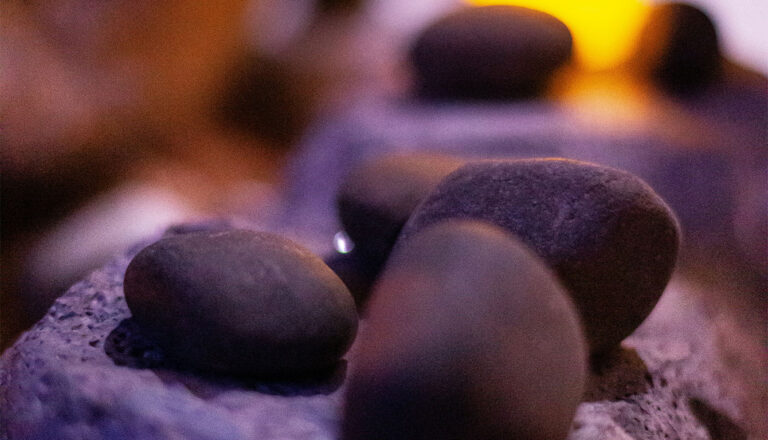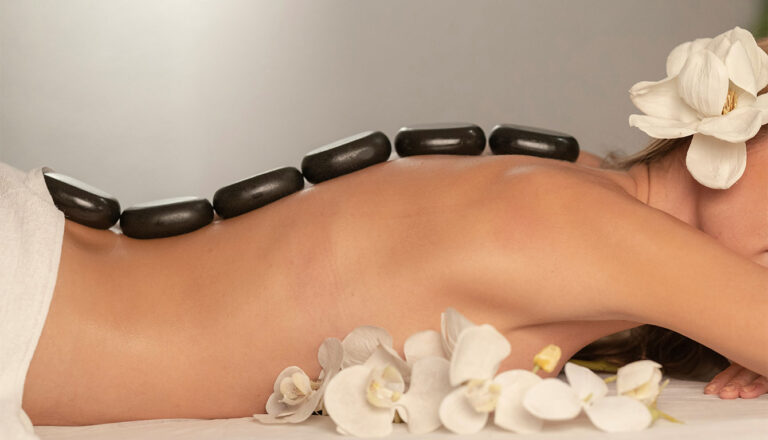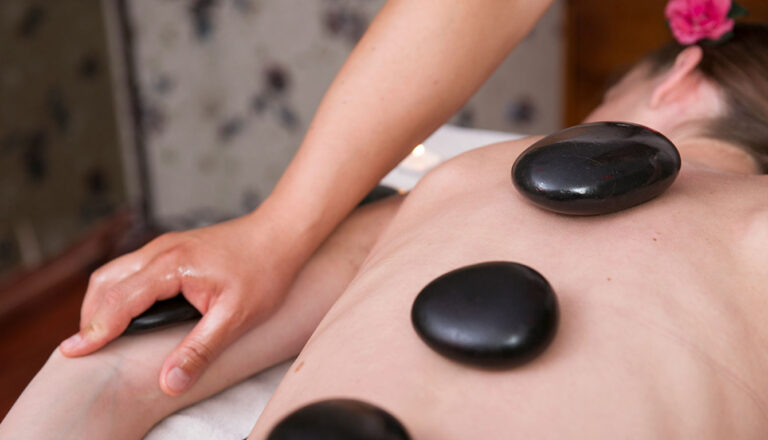Curious about which rocks therapists pick and why? This introduction explains exactly which items are chosen, the reasons behind those choices, and how their warmth supports comfort and results during a session. You will learn how heat and gentle techniques combine to promote calm and ease.
Most practitioners heat basalt in a dedicated heater to roughly 45–50°C, then place warm pieces on specific anatomical and energy points and glide with Swedish-style strokes. Professionals avoid microwaves because they give uneven and unreliable temperatures.
Safety matters: trained therapists monitor comfort, adjust heat and pressure, and advise aftercare such as drinking water. Many clients report reduced back pain, eased anxiety and deep relaxation, though research is still developing.
The guide follows common UK practice, covering clinic and mobile options. It also flags who should check suitability first — notably pregnant people, those with diabetes, high blood pressure or on blood thinners. Keep comfort central and tell your therapist if anything feels too intense.
Key Takeaways
- Basalt is the professional standard thanks to steady heat retention.
- Therapists use heaters set to about 45–50°C, not microwaves.
- Clients often feel less back pain, reduced tension and deep relaxation.
- Aftercare includes drinking water; certain health conditions need clearance.
- UK services include both clinic and mobile appointments with trained practitioners.
Hot stone massage at a glance: how heat, stones and skilled pressure relax the body and mind
A warm, rhythmic treatment combines heated rocks and steady hands to quiet the nervous system and soothe both body and mind.
How it flows: A therapist heats the implements in a purpose-made heater, checks temperatures (typically around 45–50°C) and introduces them slowly to ensure comfort. Professionals avoid microwaves because they cause uneven heat that can irritate skin.
The work has two main uses. First, placed warmth on anatomical or energy points helps melt tightness. Second, the therapist glides the warmed pieces over muscles using Swedish strokes—long, smooth moves and gentle kneading—to ease stiffness.
Well-judged pressure enhances the soothing effect. The heat softens tissues so the therapist can work more effectively without forcing deep pressure, especially over larger areas like the back and thighs.
- Continuous checks: the therapist adjusts temperature and pressure to your feedback.
- Balanced pace: sessions alternate still placements and flowing strokes to promote calm.
- Mental ease: many clients report a meditative state as breathing slows and tension drops.
| Stage | Action | Effect |
|---|---|---|
| Preparation | Heater warms implements to ~45–50°C; therapist tests temp | Safe, steady warmth ready for placement |
| Placement | Warm items placed on key points to loosen tight areas | Local relief and softer tissues |
| Gliding | Swedish-style strokes and kneading over muscles | Improved circulation and reduced stiffness |
| Monitoring | Therapist checks comfort and adjusts pressure | Comfort maintained; risk minimised |
what stones are used for hot stone massage
Therapists pick tools that hold steady warmth and feel smooth against skin. Choice depends on heat retention, surface finish and the body areas being treated. Practitioners rotate pieces so heat spreads evenly and no single contact becomes too intense.
Basalt hot stones: the smooth, volcanic standard for retaining heat
Basalt is the professional favourite because volcanic basalt absorbs heat quickly and releases it slowly. Hand-polished UK basalt is 100% natural, uncoloured and shaped with rounded edges to support comfortable kneading.
A common large basalt measures about 7.7cm x 5.7cm x 2.7cm and suits the back and other larger muscle areas.
Heated river stones: naturally rounded stones that glide over the skin
River pieces are valued for their naturally smooth curves. They glide well during long strokes and give gentle, even warmth across limbs.
Lava shells: a warmed alternative some therapists also use
Lava shells offer a different shape but similar heat behaviour. Some practitioners prefer them for ease of grip and targeted gliding.
Other stones occasionally used and why they’re less common
Other rock types appear sometimes, but irregular edges or poor heat retention can risk causing discomfort. Make sure your therapist uses a purpose-made heater and checks each piece on the hand and a towel before skin contact.
- Key needs: predictable warmth, smooth texture, practitioner skill.
- Safety: stones warmed to roughly 45–50°C and tested first.
Why basalt is preferred in professional stone massage
A key advantage of basalt lies in its ability to hold a gentle, even temperature that supports uninterrupted work.
Heat retention and slow cooling
Basalt’s mineral makeup stores heat efficiently and releases it slowly. That steady thermal behaviour means therapists can keep a calm rhythm while they rotate pieces from a dedicated heater.
Smooth texture and rounded edges
Hand-polished basalt is free of dyes or waxes. The finish glides across skin and lowers the chance of causing discomfort on bony areas.
Sizes and shapes for different areas
Practitioners use a range: large basalt (about 7.7cm x 5.7cm x 2.7cm) for backs, medium for arms and calves, small for hands and facial contours.
- Narrower edges provide gentle pressure to relax muscles without extra force.
- Slow cooling reduces frequent swapping and keeps the flow steady.
- Light oil and smooth surfaces cut skin drag for fluid movement.
“The right stone plus skilled hands equals soothing, even warmth across the session.”
| Feature | Benefit | Typical use |
|---|---|---|
| Dense basalt | Long heat retention | Full back sequences |
| Hand-polished finish | Low skin drag | Gliding strokes |
| Varied sizes | Targeted pressure | Legs, hands, face |
Safe temperatures and how therapists heat stones
Skilled practitioners use dedicated equipment to reach reliable, even temperatures. Stones typically feel warmly soothing on skin at roughly 45–50°C during treatment. To maintain that comfort, heaters are often set to around 55–60°C so pieces stabilise in a consistent water bath.
Purpose-made stone heaters heat evenly and let a therapist monitor with a thermometer. Professionals rotate pieces so each arrives at a safe level. Different sizes warm and cool at different rates, so sequencing keeps the flow steady and relaxing.
Why not microwaves?
Microwaves create hot spots and uneven results. That can burn skin or force frequent pauses. UK suppliers and clinics recommend water-bath heaters for predictable heat and better hygiene.
- Therapist always temp-checks in hand and with a towel before contact.
- Clients should speak up immediately if anything feels too warm.
- Heaters and implements are cleaned and dried between clients to maintain hygiene.
“Good equipment helps the practitioner keep a steady pace and you sure get a calm, safe session.”
| Target on body | Heater setting | Practice |
|---|---|---|
| ~45–50°C | 55–60°C | Thermometer checks; rotation |
| Varied sizes | Maintain bath | Sequence to avoid too-hot contact |
Where hot stones go and how they’re used during a massage
Placement follows anatomy and meridians so warmth eases tense bands and supports movement. Therapists often place warmed pieces along the spine, across the shoulders and over the hips to target major back tension. Smaller implements may rest in the palms or between the toes to bring focused heat to reflex points.
Placement on anatomical and acupressure points to ease tension
Practitioners align contact with recognised points and energy lines to loosen tight areas. They check each contact, especially over bony regions, and adapt pressure to maintain comfort.
Gliding Swedish strokes with stones to relax muscles
The approach alternates still placements with gentle movement. The therapist uses warmed pieces like extensions of their hands to trace long, Swedish-style strokes — kneading, rolling and gliding across the muscles to improve circulation and reduce tension.
Pairing with Swedish massage or other massage types for deeper results
Combined work keeps a calm rhythm while addressing trigger bands. Larger implements suit broad areas such as the back and thighs; smaller implements fit hands and facial contours.
- Pressure is adjusted to your comfort — lighter over sensitive areas, firmer on large muscle groups.
- Stones are rotated so temperature stays steady and movement remains fluid.
- Clients are encouraged to ask for changes in size, temperature or pace to improve the massage help they receive.
In short: strategic placement on key points plus flowing sequences spreads even warmth across the body, helping muscles relax quickly so the therapist can work effectively without excessive force. For a comparison of techniques and flow, see this discussion on hot stone vs Swedish treatment.
Stone massage benefits: warmth, relaxation and more
Combining steady warmth with gentle gliding techniques can produce fast, noticeable relaxation across the body.
Stress relief and feeling relaxed in body and mind
Warm contact and a calm rhythm help the nervous system settle. Many people report less stress and reduced anxiety after a session.
Better sleep and easing insomnia
Some clients notice improved sleep, including help with insomnia in certain groups. A relaxed mind often leads to deeper rest and steadier mood.
Improved circulation and immune system support
Heat and massage increase local blood flow. This can aid tissue recovery and may have a positive impact on the immune system after a single session.
Pain management: back pain, arthritis and fibromyalgia
Evidence suggests that thermal-assisted techniques can ease chronic pain for some people. Reported relief includes back pain and conditions such as arthritis and fibromyalgia, though results vary.
Greater flexibility and range of motion
When muscles loosen, movement often feels easier. Clients commonly report a wider range and less stiffness after treatment.
“Many people leave calmer, with reduced pain and a clearer sense of ease.”
- Warmth plus skilled touch promotes deep relaxation and muscle relaxation.
- Reduced muscle soreness and improved mobility often follow sessions.
- Responses are personal; regular visits plus hydration and gentle stretching help keep gains.
| Reported benefit | How it helps | Typical outcome |
|---|---|---|
| Relaxation | Steady warmth and rhythm calm nerves | Feeling relaxed; lower stress |
| Sleep | Reduced tension before bed | Improved sleep; less insomnia in some groups |
| Circulation & immune | Increased blood flow | Support for recovery; possible immune system impact |
| Pain & mobility | Heat softens tissues; targeted work eases tight bands | Less pain; better range and motion |
Who should be cautious: making sure you get the right massage help
Not every client suits thermal-assisted bodywork; a short medical review often prevents problems. Tell your practitioner about medications and health conditions so they can adapt the plan and keep you safe.
Medications and heat-sensitive drugs
If you take blood thinners or drugs that change heat response, seek medical advice first. Heat can raise local circulation and alter bleeding risk. Your GP can advise if a hot stone massage is appropriate.
Sensory loss, diabetes, neuropathy and high blood pressure
A lack of sensation from diabetes, neuropathy or MS raises burn risk because you may not feel excess warmth.
Those with high blood pressure should check with a clinician; intense heat may not suit some cardiovascular profiles.
Immune suppression, cancer care, pregnancy and skin
When the immune system is suppressed—during cancer treatment or with autoimmune conditions—avoid thermal work unless your team clears it.
Pregnancy, especially later stages, often calls for alternative therapies. Also avoid heated contact over inflamed skin conditions such as eczema or psoriasis.
- Always tell your therapist about medicines and medical history.
- Start with cooler stones or a traditional massage in borderline cases.
- Comfort first: you should never feel forced into heat if it causes pain.
- Make sure get clinical approval if unsure so you sure get the safest option.
| Risk | Why | Suggested action |
|---|---|---|
| Blood thinners or heat-sensitive drugs | Raised bleeding or altered drug effect | Consult GP before booking |
| Reduced sensation (diabetes, neuropathy) | High burn risk; may not detect overheating | Choose cooler contact or avoid heated work |
| Suppressed immune system / cancer | Potential infection or adverse response | Obtain explicit approval from clinician |
| Pregnancy | Positioning and heat risks in later stages | Use pregnancy-safe alternatives |
| Active skin issues | Heat can irritate eczema, psoriasis, burns | Check with GP or dermatologist first |
Choosing a therapist in the UK: safety, equipment and mobile massage services
Finding a qualified therapist means steady equipment, clear checks and tidy hygiene every visit. Ask a few questions before you book so the session meets your needs.
Ask about heater use, stone type and hygiene to make sure you’re in safe hands
Check which heater the practitioner uses and how they monitor temperature. UK professionals favour purpose-made water-bath heaters and routine thermometer checks.
Ask which stone type they prefer (many pick basalt), and how they test warmth on a towel or in the hand before contact.
Make sure linens are fresh, implements sanitised and water changed between clients. Good hygiene protects you and supports a calm session.
Booking at-home treatments for warm, relaxed comfort
Many UK therapists offer mobile massage services in cities such as London, Manchester and Brighton. At-home visits remove travel stress and let you rest straight away after treatment.
- Ask about stone rotation, towel buffering and how heat stones are cycled to keep a steady temperature.
- Discuss medical details so you make sure get an approach suited to your needs and GP advice.
- Read recent reviews and confirm qualifications and insurance for peace of mind.
“A short pre-treatment chat helps set goals and keeps the session tailored to you.”
During the session, speak up if anything feels too warm or firm. A skilled therapist will adjust pressure, placement on key points and pace promptly to keep you comfortable.
For guidance on professional equipment, see a supplier guide to heaters and kit equipment for practitioners.
Conclusion
A calm, carefully timed session can leave you noticeably more relaxed and mobile.
Basalt tends to give the most dependable warmth and smooth contact, which underpins many stone massage benefits. Professional heaters, routine temperature checks and clean kit are central to safe, effective results.
The experience usually feels cocooning: steady warmth and Swedish-style glides ease stress and tension and leave you feeling relaxed from head to toe. Many clients report better sleep, reduced pain and an improved range of movement.
If you have pregnancy, diabetes, high blood pressure, take blood thinners, have a suppressed immune system or skin sensitivity, seek tailored stone massage help or an alternative. Book a qualified UK therapist, share your goals and give feedback during the session to get the most from the treatment.
When delivered with care, heated work can be a soothing way to support body and mind and enjoy lasting benefits.
FAQ
Which types of heated rocks do therapists commonly choose?
Professionals most often select smooth basalt, a volcanic material prized for its heat retention. Some also use warmed river pebbles for gliding strokes and polished lava shells as an alternative. These options provide steady warmth and a comfortable surface for the skin.
Why is basalt the preferred option in professional practice?
Basalt holds temperature well and cools slowly, giving consistent warmth during treatment. Its naturally smooth texture and rounded shape reduce the risk of discomfort, and therapists use a variety of sizes to suit the back, legs, hands and facial areas.
What temperatures do therapists aim for when preparing heated rocks?
Safe practice calls for treatment temperatures around 45–50°C at skin contact, with heaters often set to 55–60°C to allow for safe handling. Purpose-made stone heaters are standard in clinics and mobile massage services; they control temperature reliably unlike ovens or microwaves.
Where are warmed stones typically placed during a session?
Practitioners place stones on anatomical and acupressure points to ease tension, and they also use them to perform gliding Swedish strokes to relax muscles. Stones can be positioned along the spine, on the palms, over the legs and around the shoulders to target specific areas.
What benefits can clients expect from a heated rock treatment?
Warmth promotes muscle relaxation and reduced tension, which supports stress relief and a calmer mind. Regular sessions may improve sleep, circulation and range of motion, and can help manage chronic pain such as back ache or symptoms linked to arthritis and fibromyalgia.
Who should take extra care or avoid these treatments?
People on blood thinners, with reduced sensation, diabetes, neuropathy, uncontrolled high blood pressure, a suppressed immune system or undergoing cancer care should consult a clinician before booking. Pregnancy and active skin conditions also call for alternative approaches or clearance from a healthcare professional.
How can I choose a safe therapist in the UK?
Ask about heater type, stone material and hygiene practices before booking. Check that practitioners are insured, use purpose-made equipment and can explain how they avoid overheating. Many reputable mobile massage services offer at-home treatments; confirm they follow the same safety standards as clinic-based therapists.
Can this type of therapy be combined with other approaches?
Yes. Therapists often pair warmed stones with Swedish massage techniques to deepen relaxation and improve muscle release. Combination treatments can enhance circulation and provide a more restorative experience tailored to individual needs.
Are there any alternatives if heat causes discomfort?
If heat feels uncomfortable, speak with the therapist about cooler stones, non-heated massage, or switching to another massage type such as Swedish soft tissue work. Good practitioners will adjust pressure, temperature and techniques to ensure a comfortable session.




